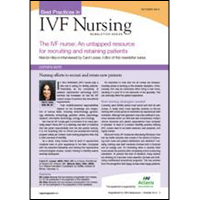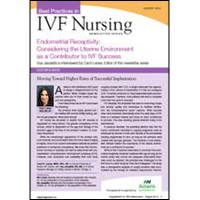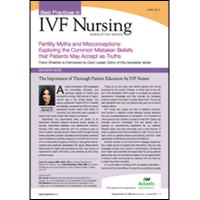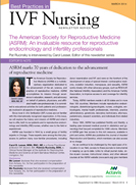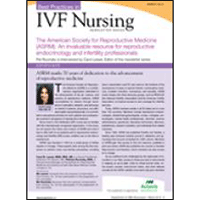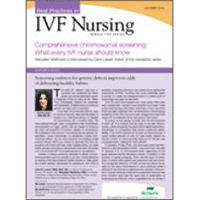User login
Best Practices in IVF Nursing: The IVF nurse—An untapped resource for recruiting and retaining patients
Click here to download the PDF.
In vitro fertilization (IVF) nurses play a vital role in caring for fertility patients. Predictably, as the complexity of assisted reproductive technology (ART) services has increased, so has the IVF nurse’s scope of practice and educational requirements.
Their multidimensional responsibilities depend on the knowledge and integration of various fields, including endocrinology, gynecology, obstetrics, embryology, genetics, ethics, psychology, research, information technology, urology, and oncology.
But how do IVF nurses gain a command of so many specialty areas?
Click here to download the PDF.
In vitro fertilization (IVF) nurses play a vital role in caring for fertility patients. Predictably, as the complexity of assisted reproductive technology (ART) services has increased, so has the IVF nurse’s scope of practice and educational requirements.
Their multidimensional responsibilities depend on the knowledge and integration of various fields, including endocrinology, gynecology, obstetrics, embryology, genetics, ethics, psychology, research, information technology, urology, and oncology.
But how do IVF nurses gain a command of so many specialty areas?
Click here to download the PDF.
In vitro fertilization (IVF) nurses play a vital role in caring for fertility patients. Predictably, as the complexity of assisted reproductive technology (ART) services has increased, so has the IVF nurse’s scope of practice and educational requirements.
Their multidimensional responsibilities depend on the knowledge and integration of various fields, including endocrinology, gynecology, obstetrics, embryology, genetics, ethics, psychology, research, information technology, urology, and oncology.
But how do IVF nurses gain a command of so many specialty areas?
Best Practices in IVF Nursing: Endometrial Receptivity: Considering the Uterine Environment as a Contributor to IVF Success
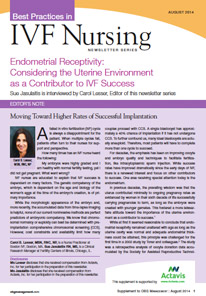
Click here to download the PDF.
A failed in vitro fertilization (IVF) cycle is always a disappointment for the patient. When multiple cycles fail, patients often turn to their nurses for support and perspective.
How many times has an IVF nurse heard the following:
My embryos were highly graded and I am healthy with normal fertility testing, yet I did not get pregnant. What went wrong?

Click here to download the PDF.
A failed in vitro fertilization (IVF) cycle is always a disappointment for the patient. When multiple cycles fail, patients often turn to their nurses for support and perspective.
How many times has an IVF nurse heard the following:
My embryos were highly graded and I am healthy with normal fertility testing, yet I did not get pregnant. What went wrong?

Click here to download the PDF.
A failed in vitro fertilization (IVF) cycle is always a disappointment for the patient. When multiple cycles fail, patients often turn to their nurses for support and perspective.
How many times has an IVF nurse heard the following:
My embryos were highly graded and I am healthy with normal fertility testing, yet I did not get pregnant. What went wrong?
Best Practices in IVF Nursing: Fertility Myths and Misconceptions: Exploring the Common Mistaken Beliefs that Patients May Accept as Truths
The Importance of Thorough Patient Education by IVF Nurses
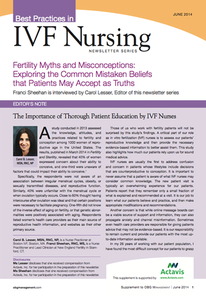
Click here to download the PDF.
A study conducted in 2013 assessed the knowledge, attitudes, and practices related to fertility and conception among 1000 women of reproductive age in the United States. The results, published in March 2014 in Fertility and Sterility, revealed that 40% of women expressed concern about their ability to conceive, and one-third were unaware of factors that could impact their ability to conceive.
The Importance of Thorough Patient Education by IVF Nurses

Click here to download the PDF.
A study conducted in 2013 assessed the knowledge, attitudes, and practices related to fertility and conception among 1000 women of reproductive age in the United States. The results, published in March 2014 in Fertility and Sterility, revealed that 40% of women expressed concern about their ability to conceive, and one-third were unaware of factors that could impact their ability to conceive.
The Importance of Thorough Patient Education by IVF Nurses

Click here to download the PDF.
A study conducted in 2013 assessed the knowledge, attitudes, and practices related to fertility and conception among 1000 women of reproductive age in the United States. The results, published in March 2014 in Fertility and Sterility, revealed that 40% of women expressed concern about their ability to conceive, and one-third were unaware of factors that could impact their ability to conceive.
Best practices in IVF nursing. The American Society for Reproductive Medicine (ASRM): An invaluable resource for reproductive endocrinology and infertility professions
The American Society for Reproductive Medicine (ASRM) is a multidisciplinary organization dedicated to the advancement of the art, science, and practice of reproductive medicine. ASRM accomplishes its mission through excellence in education, research, and advocacy on behalf of patients, physicians, and affiliated health care professionals. It is committed to educational activities for both patients and professionals involved in all aspects of reproductive medicine.
Click here to download the PDF.
The American Society for Reproductive Medicine (ASRM) is a multidisciplinary organization dedicated to the advancement of the art, science, and practice of reproductive medicine. ASRM accomplishes its mission through excellence in education, research, and advocacy on behalf of patients, physicians, and affiliated health care professionals. It is committed to educational activities for both patients and professionals involved in all aspects of reproductive medicine.
Click here to download the PDF.
The American Society for Reproductive Medicine (ASRM) is a multidisciplinary organization dedicated to the advancement of the art, science, and practice of reproductive medicine. ASRM accomplishes its mission through excellence in education, research, and advocacy on behalf of patients, physicians, and affiliated health care professionals. It is committed to educational activities for both patients and professionals involved in all aspects of reproductive medicine.
Click here to download the PDF.
